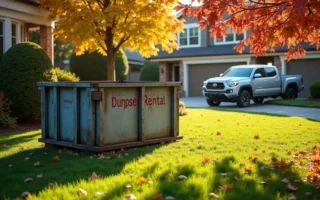Embracing sustainable practices in landscaping offers environmental benefits and a harmonious connection with the surrounding nature. Adopting this strategy allows homeowners to experiment with constructing outdoor areas that are both visually beautiful and serve as healthy ecosystems, aligning with global sustainability goals.
Understanding Sustainable Landscaping
At its heart, sustainable landscaping is about the balance between design and the natural world. It encompasses practices supporting local ecology, conserving resources, and minimizing pollutants. Engaging with this concept leads to numerous environmental benefits, including reduced water usage, decreased need for chemical fertilizers or pesticides, and lower energy consumption.
Alongside its environmental advantages, a sustainable landscape offers homeowners a serene retreat that mirrors the innate balance of nature, contributing to overall well-being.
Using Eco-friendly Materials for Landscaping

Sustainability extends beyond plant life to the materials used in constructing landscaping features. Using recycled or renewable materials for decks, pathways, and retaining walls pulls from a more responsible supply chain and often delivers a unique aesthetic that blends naturally with outdoor surroundings.
Moreover, these materials usually boast longevity and durability, which reduces the need for replacements or repairs over time, leading to a sustainable, life-long hardscaping and landscaping choice.
Reclaimed Wood
Reclaimed wood is famous for adding warmth and history to a space. When used in garden design for structures such as arbors, trellises, or benches, it serves both a functional and an ecological purpose by reducing the demand for new timber and saving old wood from landfills.
Recycled Plastic Edging
Plastic trash is a huge hazard to the ecology worldwide. Utilizing recycled plastic for garden edging helps to contain garden areas efficiently and contributes to a circulating economy by giving new life to previously used materials.
Choosing Native Plant Species
By integrating native plant species into outdoor spaces, individuals invite the essence of their region’s unspoiled habitats into their gardens. These plants are attuned to regional weather patterns and soil types and co-exist with local wildlife.
A garden filled with native species offers numerous rewards: it is resilient, low maintenance, and reduces the environmental stress of supporting non-native floras. Such landscapes become a sanctuary for pollinators and beneficial insects, helping to preserve the local ecosystem’s health and balance. If you’re looking to integrate these plants into your outdoor space, working with a company like Direct Native Plants will allow you to source region-appropriate species confidently and receive expert guidance on creating a thriving, sustainable landscape.
Water Conservation Techniques
A key pillar in sustainable landscaping is water conservation. Thoughtful strategies like efficient irrigation systems, selecting drought-resistant plant varieties, and designing landscapes that optimize natural rainfall contribute to more responsible and sustainable water management.
Homeowners who adopt these techniques act as stewards of the environment and reap the benefits of lower water costs and lush gardens that are more resilient to variable climate conditions.
Drip Irrigation Systems
Among the most effective tools for water conservation is drip irrigation, which conserves water by allowing it to drip slowly to the plants’ roots. This precision ensures the plants receive adequate hydration and drastically reduces water wastage due to evaporation and runoff, a prevalent issue with traditional sprinkler systems.
Rain Gardens
Rain gardens are beautiful and functional landscape elements that creatively manage stormwater runoff. By capturing water runoff from roofs and driveways and guiding it towards plant beds designed to absorb and filter water, rain gardens significantly mitigate the impact on local waterways while providing moisture for flourishing gardens.
Natural Pest Control Solutions
Turning away from toxic chemical treatments, sustainable landscaping involves innovative approaches to pest management that do not disrupt the ecosystem. Techniques such as beneficial insect release, companion planting, and natural deterrents provide effective pest control that respects nature’s intricate balance.
This biological approach eliminates harmful chemicals and enriches the biological diversity within the garden, fostering an environment where natural pest predators thrive and maintain balance organically.
Incorporating Composting into Your Landscape
Gardeners who integrate composting into their practices can organically boost the health of their soil, fostering robust plant growth without resorting to synthetic fertilizers. Moreover, composting closes the sustainability loop by turning food scraps and yard waste into a benefit rather than a detriment to the environment.
Green Lawncare: Alternative Grasses and Mowing Practices
In a conventional setting, lawns are one of the most resource-intensive aspects of yard maintenance, especially regarding water and chemical fertilizer usage. Green lawn care practices like using native grass blends or reducing mowing frequency can result in a lawn that’s not only environmentally sustainable but also vigorous and green.
Alternatives like micro-clover mixtures or wildflower meadows can even enhance the aesthetic diversity of the conventional lawn.
Collaborating with Nature: How to Work with the Local Ecosystem
The ultimate objective of sustainable landscaping is to combine human design with the larger ecology harmoniously. This cooperation involves creating spaces that are both a haven for people and a thriving environment for local fauna and flora. Features like bird baths, pollinator gardens, and native shrubberies contribute to the balance of local ecosystems, providing food and shelter to wildlife while establishing a living, breathing tableau that evolves with the seasons.
Explore these topics further for deep insights into why sustainable landscape designs are gaining importance. Additionally, the Nature Conservancy offers a compelling report on green infrastructure solutions, highlighting practices that benefit urban and suburban areas.




